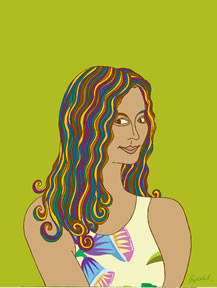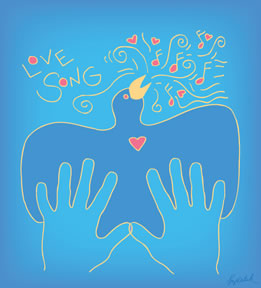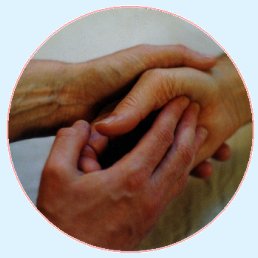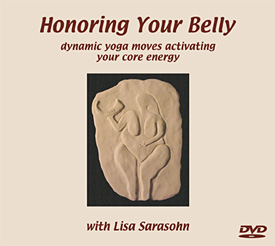Seated Massage: Advantages of giving seated massage
By Mary Kathleen Rose
Here are some of the advantages of giving massage in the upright seated position:
• Posture" The vertical seated position encourages
proper alignment of the client’s vertebral column.  The
head is over the shoulders, the shoulders are over the rib
cage, and the rib cage is over the pelvis, which is supported
comfortably by the chair seat. Many different relaxation and
meditation practices promote this alignment to optimize deep
relaxation. I often place a towel over the back of the chair
or use a thin pillow to ensure that the client is truly sitting
vertically.
The
head is over the shoulders, the shoulders are over the rib
cage, and the rib cage is over the pelvis, which is supported
comfortably by the chair seat. Many different relaxation and
meditation practices promote this alignment to optimize deep
relaxation. I often place a towel over the back of the chair
or use a thin pillow to ensure that the client is truly sitting
vertically.
• Breathing" When sitting upright, the clientis
able to breathe most fully and deeply, as the respiratory
passages are unimpeded, and the ribcage is able to move freely.
By massaging someone in this position, I am letting the support
of my touch assist the client to experience a life-affirming
posture, even as she enters into a relaxed, meditative state.
Respiratory and pulse rates lower, and the client's attention
turns inward.
• Accessibility" In this position, it is easy to
work on the head, neck, shoulders, and back. If time permits,
the arms and hands, along with the legs and feet can also
be worked. In the upright position, the therapist can easily
access the top of the shoulder and work into the motor points
of the upper trapezius muscle, key points for quickly and
easily releasing tension in the shoulders. It is also easier
to work on the upper attachments of the trapezius, as well
as other attachments along the occipital ridge, from this
position. The erector spinae and other supporting muscles
of the back can be worked using general contact pressure.
Standing to the side of the client, the back of the chair
can be used for leverage when applying pressure to her back.
(Note: I caution against using specific direct pressure on
the neck because of the vulnerability of the bony structures,
as well as the major blood vessels. It is possible to cut
off circulation to the brain, causing the client to faint.)
• Communication" Often clients will relax immediately,
closing their eyes. But others prefer to be able to talk or
give feedback as you work. This seated position allows for
an easy rapport with the client.
Ensuring Effective Outcomes
What are the factors that contribute to an effective seated
massage? What does it take to get a "wow" comment
from a client after only a 10- to 20-minute treatment? A good
seated massage involves all the skills of a competent massage
therapist including an understanding of anatomy, a clear focus
of intention, specific technique, and body patterning skills.
Understanding Anatomy
Knowledge of the human body"s structure allows therapists
to be very specific in their seated work, applying pressure
where it will be most effective in a short amount of time.
A respect for anatomy also insures that the therapist avoids
placing pressure where it is inappropriate, such as directly
against bones, where it may inhibit breathing or circulation
or where it may cause damage and/or discomfort.
Your knowledge of the direction and placement of muscles
and tendons allows you to identify common areas of tension
more quickly, acknowledging those areas through the warmth
and pressure of your touch. Knowledge
of the motor points of the major extrinsic muscles can guide
you in the use of a specific technique. For example, the motor
point (area of greatest neuro-electrical activity) of the
trapezius is in the belly of the upper part of the muscle.
Pressure applied directly onto this point usually elicits
response from the client. Repeatedly, I hear clients say,
That"s the point! How did you find that so quickly?
Learning from both the Western and Eastern perspectives,
we find correlation between neuromuscular anatomy and the
map of the human body defined through the meridian and acupressure
point systems. Again, the motor point in the belly of the
trapezius corresponds to the acupressure point called Gallbladder
21 or shoulder well. The motor point of the tibialis muscle
corresponds to Stomach 36, a point below and lateral to the
knee known to relieve fatigue in the legs.
Focus of Intention
In a typical seated massage, particularly in a public setting,
there is not much time to assess clients or create a plan
of treatment. Rather, my intention is to give them a few minutes
of relief from the stress of their lives. Ask them a few simple
questions: How can I help you today? Is there anything you
want me to be aware of? Their answers will help you focus
on their needs and prioritize your time.
The client may have a list of complaints or may say they
simply need to relax. If that's the case, and given the time
you have, focus on the intention of overall relaxation, allowing
more time for the areas mentioned by the client. The individual
is assured by the respectful and caring attitude you convey
by your presence.
Take a few moments before each session to mentally prepare to be with the client. The concept of grounding is helpful, as you envision yourself connected to the earth beneath you. Grounding helps you establish and maintain rapport with your clients. If you are personally grounded, you inspire a sense of confidence and groundedness in others. Be sure you are breathing fully and deeply. Notice that when your own breath is relaxed and full, the client will respond by breathing more fully, even without being asked.
If you are personally grounded, you inspire a sense of confidence and groundedness in others. Be sure you are breathing fully and deeply. Notice that when your own breath is relaxed and full, the client will respond by breathing more fully, even without being asked.
Technique
Techniques involving compression, such as shiatsu and acupressure, lend themselves easily to seated massage because they can be practiced on a client who is fully clothed. In seated massage, I use techniques I know are safe and effective for the broadest range of people. I tend to begin a session by using broad compression (i.e., to the trapezius muscle on the top of the shoulder or the muscles of the upper back). As these areas begin to soften and warm, use more specific pressure into the belly of the muscle, as in the motor point (Gallbladder 21 point) of the upper trapezius. Likewise, broad compression, applied with the palm or heel of the hand to the broad surfaces of the rhomboids and erector muscles of the back, allows the client to relax.
Whatever part of the body you touch, begin by using broad pressure before getting deeper or more specific. As you do apply deeper pressure, ask the client for feedback, and watch for their nonverbal cues. Also, when applying deeper pressure, use the pads of two or three fingers to press deeper into a specific point. When using a thumb, be sure it has the support of your body behind it.
Contact circling is a very effective technique for working deeper into a muscle. Begin with direct pressure, then slowly move into the point of contact as if spiraling into a deeper layer. Then, hold the pressure at this new level a few seconds before releasing.
Other useful techniques include lifting, squeezing, rolling, cross-fiber friction, and percussion. In using any of these techniques, contact can be made with the broadest possible surface of the hand, or fingertips, to avoid a feeling of poking or pinching. Percussion is only used over the thickest part of the muscle, such as the belly of the trapezius or the rhomboids, and is applied with an even pressure in a relaxed and upbeat, rhythmic tempo. This is a great technique for ending a seated session, as it enforces the release of tension, while stimulating and energizing the client. Never use percussion over, or too close to, the spine.
Be cautious in the use of stretching techniques in the seated position. You can cause more discomfort by stretching without sufficient warm-up and evaluation of the client’s range of motion.
Timing is a key element of a good seated massage session, as well as the rhythm of the massage itself. Interestingly, I find that by slowing down, my work is more effective. Too often the tendency when offering short sessions is to try and speed through, touching as much of the body as possible. Not only is this hard work for the therapist, but clients can feel the rushed pace and actually be inhibited in their ability to relax. If the therapist is truly relaxed, and focused in the use of a precise technique, much can be accomplished in a very short time.
Body Patterning
Self-care is imperative for the therapist who offers the healing benefit of touch to others. If you are ungrounded or uncomfortable in your body, the client will sense your discomfort. If you are fully present in your body, you discover that the quality of your touch is not only conveyed through your hands, but through your whole body and being. Think about your feet even before you touch your client. Feel your connection to the earth. Let your breathing be full and deep. This is the beginning of an awareness that will guide you to use your body most efficiently and lessen the chances of fatigue or injury over time.
As you touch your client, step into your work as movement
expert Mary Ann Foster advises.1
Let your body be aligned behind the point of contact. As you
exert more pressure through your hands, you will simultaneously
exert an equal pressure through your feet. This allows your
nervous system to work more coherently and efficiently. The
client will benefit by the greater amount of radiant energy
available, and you will be able to relax and flow into your
touch.
I make ample use of a stool (a folding metal chair that is lightweight, but stable), often sitting near my client, to facilitate easy access to the shoulders, arms, and hands. Even here, I maintain an awareness of my feet as they contact the floor. Often, I let one elbow rest on my knee to support the other arm to give myself a broader base of support. In Comfort Touch workshops, I teach bodyworkers other ways to use the stool while standing, as they work on the upper body. I also use a small kitchen stool (9 inches high) or cushion to sit on the floor when working on the lower legs and feet.2
Your hands are endowed with tactile corpuscles, abundantly located in the palms of the hands and to a lesser extent in the fingertips. These corpuscles allow you to gauge the appropriate amount of pressure to give the client, in response to their kinesthetic feedback. When the body is aligned properly, you have access to the greatest potential energy to flow through your body, in turn relaxing and invigorating the person you are touching, without overworking yourself.
In the Toolbox
Good seated massage techniques should be in the toolbox of
every professional bodyworker. With attention to self-care
and the skillful use of appropriate techniques, it is a way
to enhance your practice of massage. Ask yourself this question,
How quickly can I get myself personally grounded, feeling
my connection to the earth with all of my resources and energy
available? Then how quickly can I tune into the energy and
needs of the client? Not by diagnosing their condition, but
by listening respectfully as they answer the question, How
can I help you today?
This process is at once simple, as well as challenging. With
practice and a sincere desire to help others, you realize
how rewarding it is to touch someone with a healing focus
of intention. You allow the individual to relax and rejuvenate,
knowing you made their world a better place in only a few
minutes.
References
1 Foster, Mary Ann. Your Birthright: A Case for the Human
Stance. Massage & Bodywork 2005 April/May; 20(2): 72.
2 Rose, Mary Kathleen. Comfort Touch:
Massage for the Elderly and the Ill , Video and Guide. Wild
Rose, Boulder: 2004.
Resource
Thompson, Gerry. Shiatsu: A Complete Step-by-Step Guide .
Sterling Publishing Co., Inc. New York: 1994.
 Mary
Kathleen Rose, CMT, has more than 25 years of experience in
the holistic health field, practicing and teaching shiatsu,
integrative massage, and body energy therapies. She is the
developer of Comfort Touch™, a style of massage appropriate
for the elderly and the ill. She supervises the massage therapy
program at HospiceCare of Boulder and Broomfield counties
in Colorado and teaches in various massage schools and medical
settings.
Mary
Kathleen Rose, CMT, has more than 25 years of experience in
the holistic health field, practicing and teaching shiatsu,
integrative massage, and body energy therapies. She is the
developer of Comfort Touch™, a style of massage appropriate
for the elderly and the ill. She supervises the massage therapy
program at HospiceCare of Boulder and Broomfield counties
in Colorado and teaches in various massage schools and medical
settings.

COMFORT
TOUCH DVD - NOW AVAILABLE
 This beautifully produced video introduces the viewer to
the principles and techniques of Comfort Touch, a nurturing
form of acupressure massage designed to be safe and appropriate
for the elderly and the ill. Drawing on her many years of
experience practicing and teaching this work in home-care
and medical settings, Mary Kathleen Rose shares the essential
elements of Comfort Touch with demonstrations of its applications
in the seated, supine and side-lying positions.
This beautifully produced video introduces the viewer to
the principles and techniques of Comfort Touch, a nurturing
form of acupressure massage designed to be safe and appropriate
for the elderly and the ill. Drawing on her many years of
experience practicing and teaching this work in home-care
and medical settings, Mary Kathleen Rose shares the essential
elements of Comfort Touch with demonstrations of its applications
in the seated, supine and side-lying positions.
This program will inspire the viewer - whether healthcare
professional or family caregiver - to offer the benefits
of touch to those for whom conventional massage may cause
discomfort or even injury. While Comfort Touch provides
soothing relief for the elderly and the ill, it can enhance
the quality of life for anyone in need of a caring touch.
Includes 40-page Video Guide, complete with Principles
and Techniques of Comfort Touch, Benefits of Comfort Touch,
Precautions in the Use of Touch and Self-Care Exercises
for the Caregiver. Yours
for $29.00 plus shipping.
Honoring Your Belly DVD
 Honoring Your Belly
Honoring Your Belly
with Lisa Sarasohn
This 35-minute DVD teaches you a dynamic sequence of belly-energizing yoga moves that develop and direct the Source Energy concentrated in your body's center.
In circle, four women de monstrate the 12-minute sequence of 23 power-centering moves as a rite for reconsecrating our womanhood. Instruction in each of the moves follows, complete with easy preparations and alternate forms. Ancient icons show how each gesture animates a symbol of the Sacred Feminine.
Price: $19.95
Order Honoring Your Belly DVD in our Bookshop








